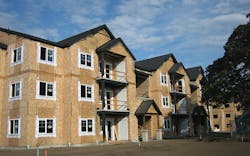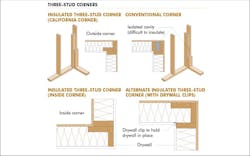Simple techniques reduce costs, boost efficiency
As architects continue to search for ways to reduce costs and improve building efficiencies, more and more are turning to advanced framing methods, particularly for multifamily and light commercial projects.
Also known as “optimum value engineering” (OVE), advanced framing techniques optimize material usage to cut down on waste, eliminate redundancies, reduce labor and increase a structure’s energy efficiency, while maintaining structural integrity.
Benefits of Advanced Framing
Energy Efficiency
Advanced framing delivers significant energy performance and cost savings in wall systems by maximizing space for cavity insulation and minimizing the potential for insulation voids. Walls built with 2x6 wood framing spaced 24 inches on center have larger insulation cavities than conventional 2x4 framing spaced 16 inches on center, increasing the amount of insulation inside the wall and improving the whole-wall R-value. In addition, the methods simplify the installation of insulation and air sealing.
Cost Effectiveness
Advanced framing is less expensive than conventional framing because it is more resource efficient. By optimizing material use, floor and wall framing material costs can be reduced by up to 30% while reducing framing installation labor.
Structural Integrity
When properly constructed, walls built using advanced framing that are fully sheathed with wood structural panels provide strength for the structure to safely withstand design loads. When vertical framing members are aligned under the roof trusses or rafters, a direct load path is created where compression and tension loads are directly transferred through the vertical framing members, resulting in a stronger structure with fewer framing members subject to stresses.
Sustainability
Advanced framing techniques fit well with green building strategies. Wood is one of the most sustainable building materials, and its efficient manufacturing process requires far less energy than steel and concrete manufacturing. Advanced framing techniques deliver greater environmental dividends by optimizing material usage and reducing construction waste. Many advanced framing techniques may be eligible for points under the leading green building standards and guidelines, such as the National Green Building Standard™ (ICC 700-2008) and the U.S. Green Building Council LEED® for Homes Rating System.
Three Advanced Framing Techniques
Advanced framing can be implemented in pieces, depending on the design of the building and the expertise of the framing crews. The following techniques make the most sense for multifamily and light commercial buildings and can be adopted one at a time. These concepts focus on increasing cavity insulation and reducing thermal bridging, providing overall higher whole-wall R-values.
1. 2x6 Framing Placed 24” on Center
For structures up to a certain height, moving from traditional 16" o.c. spacing to 24" can trim the number of required studs by about one-third. Walls built with 2x6 wood framing spaced 24” o.c. have larger insulation cavities than conventional 2x4 framing spaced 16” o.c., thereby increasing the amount of insulation inside the wall and improving the whole-wall R-value.
Switching from 2x4s at 16" o.c. to 2x6s at 24" o.c. also decreases the number of pieces, offsetting the cost of the deeper framing members.
2. Right-Sized, Insulated Headers
Size the header for the load. Often, unnecessary headers are specified out of habit; engineers’ standard header tables typically fill up the depth of the wall.
Advanced framing headers are sized for the loads they carry and are often installed in single plies rather than double. Advanced framing headers offer increased energy efficiency by replacing framing materials with space for cavity insulation inside the header.
Headers at openings in non-load-bearing walls are not required. The top of the opening can typically be framed with a flatwise member the same dimensions as the wall studs.
3. Corners
Insulated corners eliminate the isolated cavity found in conventional three- or four-stud corners, provide more space for cavity insulation and make it easier to install insulation.
Advanced framing wall corners include insulated three-stud corners (sometimes referred to as California corners) (see figure) and two-stud corner junctions with ladder blocking.
Find additional information, guidance and free resources on advanced framing at apawood.org/advanced-framing.

